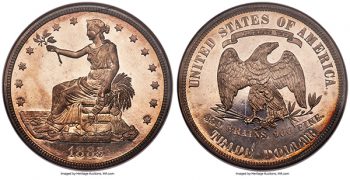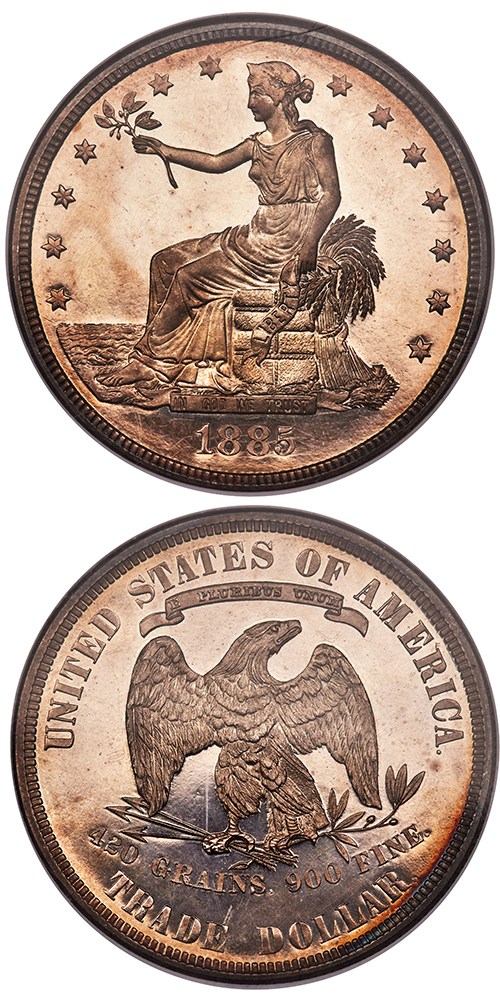

With more than 10,000 lots, Heritage Auctions’ sale line-up associated with the Florida United Numismatists Show Jan. 9-14, will present collectors the stuff of dreams.
Kicking off the rarities is one of the most sought-after U.S. coins of all time. The finest of five examples known to exist of the 1885 Trade Dollar will cross the block Jan. 11 during Heritage’s Platinum Night auction. The example was acquired by William Cutler Atwater sometime before 1923. Atwater compiled one of the most important collections of the first half of the 20th century.
It is not difficult to see why Atwater found this particular 1885 Trade Dollar easy on the eyes: The impeccably preserved surfaces include deeply mirrored fields that exhibit noticeable, if undesignated, cameo contrast with the frosty devices. Highlights of champagne-gold toning enhance the terrific eye appeal of this spectacular piece.
Special offerings continue as Heritage presents Part I of The Alan V. Weinberg Collection. Weinberg began assembling his top notch, highly selective collection of early American rarities while a child in the late 1950s. Highlights include the second finest known specimen of the 1793 Chain Cent, AMERI., S-1, B-1, R.4, MS64+ Brown PCGS Secure. CAC. Of extreme historical importance, the Chain AMERI. cents were the first copper coins actually struck at the U.S. Mint for use in commerce. Interestingly enough, Weinberg acquired the coin on New Year’s Eve, 1996, at his kitchen table from fellow collector Ted Naftzger, making Heritage’s FUN sale the first time this amazing coin has appeared in a public auction.
Among the 23 pieces from the Weinberg Collection set for FUN 2019 is the rare and historic early pattern 1792 Silver Center Cent, SP58+ Brown. Produced in the earliest days of the United States Mint, it is virtually impossible to overstate the importance of the 1792 Silver Center cent. With only 12 examples currently traced, it is among the rarest and most historically interesting issues in all of American coinage.
Part II of the Weinberg Collectionwill be offered at FUN 2020, including superb Massachusetts colonial silver and then his extensive rare American medals collection in the following years.

The famous 1943 “copper” Lincoln cent discovery coin from the late Don Lutes, Jr., will make numismatic history during Platinum Night, when it is offered for the first time since its discovery in a Pittsfield, Massachusetts, cafeteria. The 1943 Cent Struck on a Bronze Planchet, AU53 NGC, is the most famous error coin in American numismatics and remains listed among both the 100 Greatest U.S. Coinsand the 100 Greatest U.S. Error Coins.
As copper planchets were phased out in 1943 to reallocate the valuable metal to the United States’ World War II effort, the Treasury Department authorized the U.S. Mint to strike all 1943 Lincoln cents on zinc-coated steel. However, rumors of extremely rare 1943 “copper pennies” began to circulate soon after, despite the Mint steadfastly denied any copper specimens had been struck in 1943.
The appeal of the 1943 “copper cent” took on legendary status, far transcending traditional numismatics. The issue has captured the imagination of coin collectors, schoolchildren, and members of the public alike. Despite relentless searching by eager collectors over a period of more than 70 years, only a handful of legitimate specimens have surfaced.
But it was the lucky Don Lutes, Jr., who discovered the actual coin. The 16-year-old high school student found it in the pocket change he received from his school cafeteria in March 1947. Lutes was old enough to remember the “steel” cents struck in 1943, which were still commonly seen in circulation at the time, so this copper-colored example aroused his curiosity. As a coin collector, he set the coin aside for future study, but did not publicize his find until years later.
From a privately owned HBC Collection comes an important gathering of U.S. and Territorial gold coins of many denominations. The premier coin of the collection is the 1879 Coiled Hair Stella, Judd-1638, graded PR66 Cameo by NGC, one of only 13 examples traced. Another classic rarity is the 1875 three dollar gold piece, graded PR65 Cameo by NGC. A proof-only issue with a reported mintage of just 20 pieces, the HBC Collection example is an attractive Gem with sharply detailed and frosty design elements, which contrast boldly with deeply mirrored fields. The combination produces an irresistible and dramatic cameo effect.
The Charles McNutt Collection is dimecollector heaven– Mercury dimes, to be exact. It ranks within the all-time top five Registry Sets for Mercury dimes in every circulation strike category (and within the top three all-time sets in most categories) according to the current PCGS Set Registry listings. PCGS Plus designations and CAC endorsements accompany a great many of the collection’s finest specimens, including a 1916-D graded MS66 Full Bands PCGS Secure, the 1918-S graded MS67 Full Bands PCGS Secure, CAC, and a 1919-D, which is certified MS66 Full Bands PCGS Secure, CAC.
Bringing a bit of variety to the show auctions is The Don “H2O” Haley Hobo Nickel Collection. Haley was introduced to hobo nickels in 1988 and later became “Member No. 9” of the Original Hobo Nickel Society, during which he formed one of the top hobo nickel collections. Selections will be offered January 11 and January 14. Both Classic Era (pre-1940) and modern carvers are represented in the collection, which includes more than 30 coveted carvings by “Bo” Hughes and at least seven rare “Bert” Wiegand examples.
RARE $100 1878 SILVER CERTIFICATE SURFACES AT PLATINUM NIGHT
The appearance of the rare $100 1878 Silver Certificate, PCGS Very Fine 35, in Heritage’s FUN Currency Platinum Night marks the first time in 30 years that any $100 1878 Silver Certificate has been available to the collecting public, and the first time in four decades since a specimen has appeared at public auction.

The note carries a pre-sale estimate of $150,000-up, possibly a conservative figure considering not one collector in this generation has ever had the opportunity to acquire any note of this type.
“It’s an extraordinary opportunity for the hobby to own the finest of only four known and the first of the two privately held examples to reach auction,” said Dustin Johnston, Director of Currency Auctions at Heritage. “Fortunately for collectors, this note’s grade is commensurate with its rarity.”
All of the short-lived Series 1878 Silvers come countersigned. Five Friedberg numbers are listed for this type, but of the five, two remain unknown while two are represented by a single example ensconced in an institutional or government holding. That leaves the Friedberg 337b as the sole collectible example of this type and denomination. While four specimens are reported, two of the four repose in government hands, one in the Smithsonian and a second in the display which can be found in the vaults of the Federal Reserve Bank of San Francisco.
The piece offered is considerably the finest of the pair in public hands, with the other example previously having been graded Fine-Very Fine prior to its last public appearance in a 1989 Fixed Price List. This note brings with it a distinguished numismatic pedigree, having been discovered by Dr. Howard Carter as part of the famed Oat Bin Hoard.
It served as the plate example in both the Donlon and Hessler references, and was previously owned back in the 1970’s by Dean Oakes and Morey Perlmutter before a single auction appearance in October, 1976, after which it disappeared from public view until its appearance in Heritage Auctions’ Jan. 9-14 FUN Currency Auction.
To learn more about auction schedule tied to the Florida United Numismatists Show, visit Heritage’s numismatic portal at Coins.HA.com.
Want to receive COINage magazine in your mailbox or inbox? Subscribe today!












